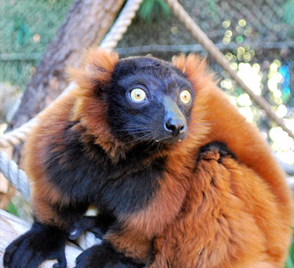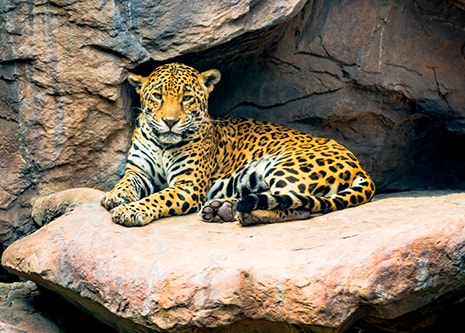
- VisitSupport Happy HollowDONATE TODAYExploreSupport Happy HollowDONATE TODAYLearnSupport Happy HollowDONATE TODAYSupportToday’s Hours: CLOSEDZoo on the Hill
Red ruffed lemur

Scientific name: Varecia rubra
Family: Lemuridae
Order: Primates
Class: Mammalia
Range: Masoala Peninsula of northeastern Madagascar
Habitat: Subtropical and Tropical Rainforest Lifespan: 15-20 years in the wild; over 30 years in captivityLifespan: 20 years
What do they look like?
Red ruffed lemurs are one of two species of ruffed lemurs, separated from each other by the Antainambalana River in eastern Madagascar. Nearly identical to each other aside from coloration, red ruffed and black-and-white ruffed lemurs are named for the tufts of hair lining their ears and faces. Red ruffed lemurs have red coats with black faces, hands, feet, and tails. They often have patches of white on the back of the neck and the base of the tail. They have large, forward-facing eyes and fox-like muzzles. Ruffed lemurs are the largest of the lemur species, typically weighing eight to 12 pounds. Their body length is approximately 20 to 22 inches, while their tails are around 24 inches long.How do they behave?
Red ruffed lemurs have a variable social system with family groups of anywhere from 2 to 32 individuals, depending on seasonality and resource availability. They are a crepuscular (mainly active at dawn and dusk), arboreal (tree dwelling) species. Females are the dominant sex in the lemur hierarchy, a system unique to this suborder of prosimians. Females will defend their territory, choose their own mate, and have first access to foraging opportunities. Ruffed lemurs communicate through loud vocalizations which can be heard up to a mile away. The most common calls are alarm calls (which are even specific to different types of predators) and locator calls (which are used to locate members of the troop).What’s do they eat?
Red ruffed lemurs are frugivores (feeding primarily on fruit) although they also consume leaves, flowers and nectar. Ruffed lemurs play an important ecological role in Madagascar. They cannot digest the seeds of the fruit they consume; therefore, the seeds are dispersed in their droppings, helping to replant vegetation throughout the region. At Happy Hollow, they eat specialized leaf-eater chow, fruits, and vegetables.How are they born?
Bonded pairs are believed to be monogamous among this species. Mating takes place from May to July, during the cooler, drier months in Madagascar. Toward the end of the gestation period, which lasts approximately 102 days, the female will build a nest for her young. Twins and triplets are most common; however, litters of six have been noted in captivity. Newborns are born fully furred with open eyes, though they do not have the strength yet to hold on to their mothers for travel. They will live in the nest for up to two weeks, at which time the mother will begin to carry them and place them in nearby trees while she forages.Conservation
The red ruffed lemur conservation status is listed as Critically Endangered by the International Union for Conservation of Nature. One of the main threats to these lemurs is habitat loss and human predation. In 2012 the Duke Lemur Center adopted the SAVA (Sambava-Andapa-Vohemar-Antalaha) Conservation Madagascar initiative, a program designed to improve the conservation status of lemurs in Madagascar. SAVA Conservation Madagascar focuses on community-based conservation, research, and habitat preservation. If you would like to help red ruffed lemurs you can start by purchasing coffee that is shade-grown and produce that is grown locally. These products do not require the destruction of rainforest land to grow crops, and they will help out your local economy.
Zoo in the Hollow
Follow the crooked bamboo pathway down into the hollow and visit with some of the most amazing animals in the world. Where else in San José can you get up close to a stunning jaguar, lemur, meerkat or American alligator? Happy Hollow is dedicated to helping save species and preserve wildlife for future generations by participating in Species Survival Plan programs through the Association of Zoos and Aquariums.
See Animals
Education Ambassadors
From camps and classes to scout badges and sleepovers, Happy Hollow education programs have something for everyone! The zoo education program offers a broad range of hands-on, engaging programs and public presentations featuring education ambassador animals. These encounters are designed to connect you to wildlife and the conservation of their habitats around the world.
See AnimalsVisit Us Today
Plan an unforgettable experience at San Jose’s family-friendly park and zoo.
Learn More